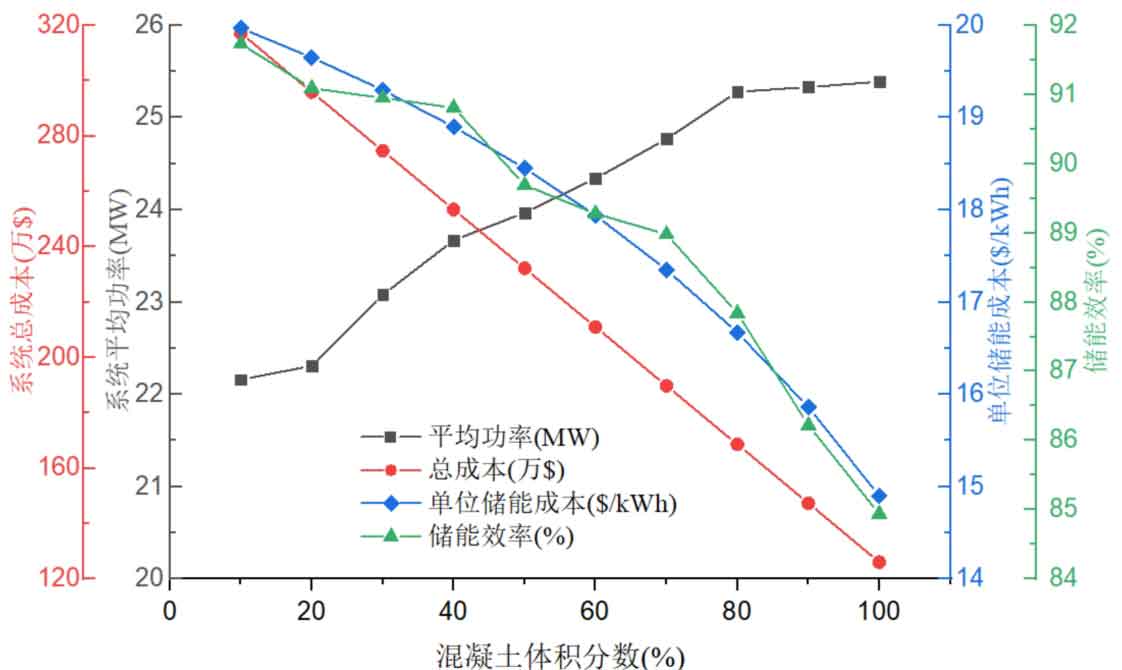Using concrete to replace some phase change materials can reduce the unit energy storage cost of the system and improve the heat transfer rate. By comparing different energy storage systems, it was found that the unit energy storage cost of the sensible latent heat combined energy storage system is relatively low, making it an ideal solution to replace the traditional dual tank molten salt energy storage system. The above only analyzed the energy storage cost of the system for one type of concrete volume fraction. Different concrete volume fractions have an impact on the energy storage and energy storage cost of the system. Therefore, it is necessary to analyze the impact of changes in energy storage and material costs on the energy storage cost of the system for different concrete volume fractions.
The top and bottom of the sensible latent heat combined energy storage system are respectively equipped with high-temperature and low-temperature phase change materials with the same volume fraction, and solid concrete materials are set in the middle. The volume fraction of concrete starts at 10% and increases by 10% each time until it reaches 100%. When the volume fraction of concrete is 100%, the system becomes a solid sensible heat energy storage. By comparing the changes in the unit energy storage cost of the system under different concrete densities, analyze the magnitude of their effects.
The comparison of various indicators of energy storage systems under different concrete volume fractions is shown in the figure. From the graph, it can be seen that as the proportion of concrete continues to increase, the total cost of the system decreases. This is because the cost of concrete materials is lower compared to phase change materials, and it also saves the packaging cost of replacing some phase change materials, resulting in a decrease in total cost. Meanwhile, due to the stronger thermal storage capacity of phase change materials, using concrete instead of phase change materials will lead to a decrease in the total energy storage of the system. The overall effect of the two is that the unit energy storage cost of the system decreases as the proportion of concrete increases. When the proportion of concrete is 10%, the unit energy storage cost of the system is 19.97 $/kWh. When the proportion of concrete is 100%, the unit energy storage cost of the system is 14.90 $/kWh, a decrease of 25.39%, indicating that the volume fraction of concrete has a significant impact on the unit energy storage cost of the system.

Due to the higher thermal conductivity of concrete compared to phase change materials, the larger the proportion of concrete in the system, the shorter the time required for the energy storage system. Therefore, as the volume fraction of concrete increases, the energy storage rate of the system increases. When the proportion of concrete volume increases to 80%, further increasing the proportion of concrete results in a slow increase in the rate of energy storage system. However, for the efficiency of energy storage systems, as shown in the figure, as the volume fraction of concrete increases, the efficiency of the energy storage system decreases. This is because as the proportion of concrete increases, the energy stored in the system decreases, and at the same time, the energy transferred by the fluid to the energy storage medium during the energy storage process decreases. The combined effect of the two reduces the efficiency of the energy storage system. When the volume fraction of concrete exceeds 50%, the energy storage efficiency of the system is less than 90%. In order to balance the energy storage cost, energy storage rate, and energy storage system efficiency, a 50% concrete volume fraction is a relatively optimal choice. This ensures that the total system cost is not too high and can also make the energy storage system efficiency relatively high.
